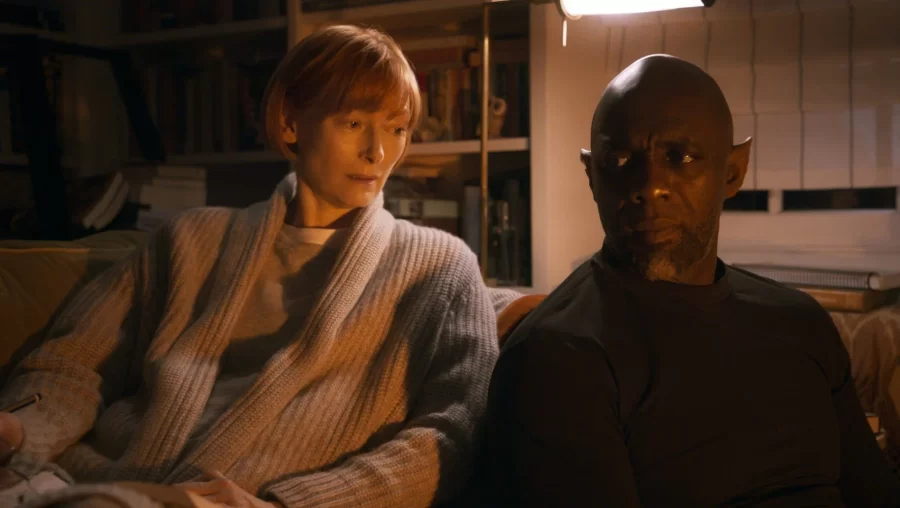The Maximalist Fantasy and Love of “Three Thousand Years of Longing”
“Mad Max” director George Miller balances bonkers imagery and a touching love story in one of the year’s most excitingly original movies.
The first thing you see at the beginning of “Three Thousand Years of Longing” (and so many other movies) is a golden banner, dramatically lit from behind, reading “Art for Art’s Sake.” The letters then turn to their Latin equivalent, “Ars Gratia Artis.” The banner eventually soars over a roaring lion, forming the iconic MGM Studios logo. While these words and this image aren’t unique to the movie, they are, in a way, the perfect encapsulation of what makes it such a furiously enchanting work of art.
“Three Thousand Years of Longing” tells the story of a stubborn narratologist named Alithea and her bizarre encounter with a magical djinn who must grant her three wishes in order to be freed from his bottle. Thinking herself totally happy and satisfied, Alithea, played by Tilda Swinton, refuses to make any of her wishes. The frustrated djinn, played by Idris Elba, tells her three cautionary stories from his past in an attempt to get her to wish, and to free him.
This is the latest release from director George Miller, best known for his work in a wildly different cinematic world, the “Mad Max” series of movies. For over 40 years, Miller has made a name for himself with broad, visually-stunning stories based in sincerity and fable-like morality. While it may seem like a total 180 to go from post-apocalyptic anarchy to a fantasy romance about a middle-aged bookworm, there are more stylistic similarities than you might expect. It is in the djinn’s three stories that we really see Miller’s gift for bombastic, maximalist imagery.
Clearly influenced by the Middle Eastern folk tale collection, “One Thousand and One Nights,” these three tales range from the wooing of the Queen of Sheba to the djinn’s own romance with a merchant’s wife in 19th century Turkey. In each story, all based in their own respective time periods, we see the hope and folly of falling in love with someone. It can lead to despair, to imprisonment, but it can also lead to total enlightenment. Alithea, a woman who had kept staunchly to herself for decades, listens with open ears, eventually sharing her own turbulent life story with the djinn.
Each world is lushly realized, with massive, elaborate sets, brightly-colored costume design, and an ever-changing supporting cast of warriors, concubines, and even human-animal hybrids. It’s hard not to think about the Oscar-winning aesthetics of “Mad Max: Fury Road” here. Each scene is full of countless visual surprises, begging the question of how they could all be taken in with one viewing.
The sheer size of the production is a throwback, in a way. The past decade has been dominated by streaming content. The still-growing prevalence of watching movies and TV shows on smartphones or laptops has changed the way movies are made. Instead of a dynamic range of color and tone, many Netflix movies have opted for less contrast in their images, so as to play better on a smartphone with a limited display.
“Three Thousand Years of Longing” takes no such route. In keeping with its drawing from “One Thousand and One Nights,” the aesthetics prioritize bright colors and detailed tableaux of people. Forget “Harry Potter” and “The Lord of the Rings,” this movie looks like “The Ten Commandments” cranked up to 11. It speaks to the power of movies as a visual medium, conveying things that could never be simply told or described.
Beyond its strange, thrilling visuals, the movie possesses something that few releases this year have: a true beating heart. While many movies talk about love, and even show the motions of engaging in a relationship, “Three Thousand Years of Longing” is about love in every element of its production. Alithea and the djinn are two people who have been repeatedly hurt by the presence (and subsequent absence) of love in their life. They found their respective person, only to have them revealed otherwise.
While each of the stories shown here displays heartbreak, director Miller reinforces that love is the force that drives everything. It pushes us toward our goals, it drives us to protect ourselves from harm, and sometimes, it brings you to a shop with a bottle that happens to contain a djinn.
The metanarrative here is fairly clear. Miller, a veteran director with decades of virtuosic filmmaking under his belt, is exploring why we tell each other stories, why he has made a career of telling such wild, freewheeling stories. In this movie, the djinn tells stories to make sense of his past. Sure, he tells them for Alithea, but as they unfold, you realize that he needs them just as much as she does. He tries to piece together the events of his 10,000-year life into a narrative, hoping that the ups and downs add up to something greater.
How often in heartbreak do we turn to our friends, to detail what happened, and try to understand why it didn’t work? How often do we return to memories of love to remind us to keep going? In a way, all of these experiences are storytelling. Love, however failed or painful, is still a story, from you, to yourself. And we need them as much as we need food or air.
There’s a very good chance that you didn’t even know this was in theaters right now. While a small marketing campaign has been active for months, the movie has only grossed under $10 million against a relatively hefty $60 million budget. This is your sign to go see it. With the influx of box office juggernauts like “Jurassic Park: Dominion,” “Top Gun: Maverick,” and even the re-release of “Spider-Man: No Way Home,” it can be hard to find something that really feels new. And thanks to George Miller, it looks like we have living proof that “Art for Art’s Sake” still has a place in the film industry.











